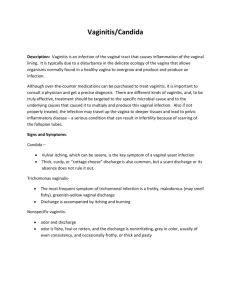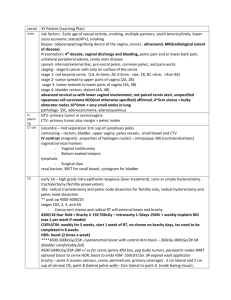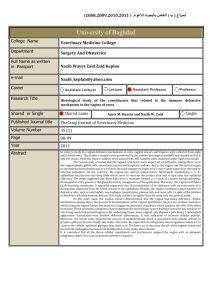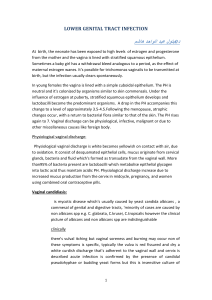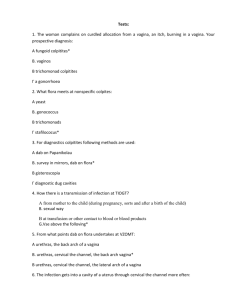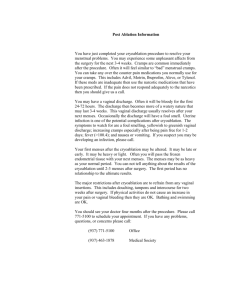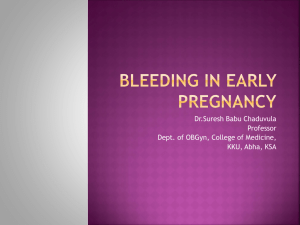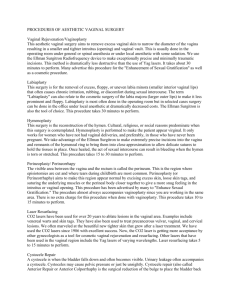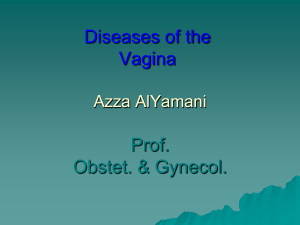Female Reproductive Notes
advertisement
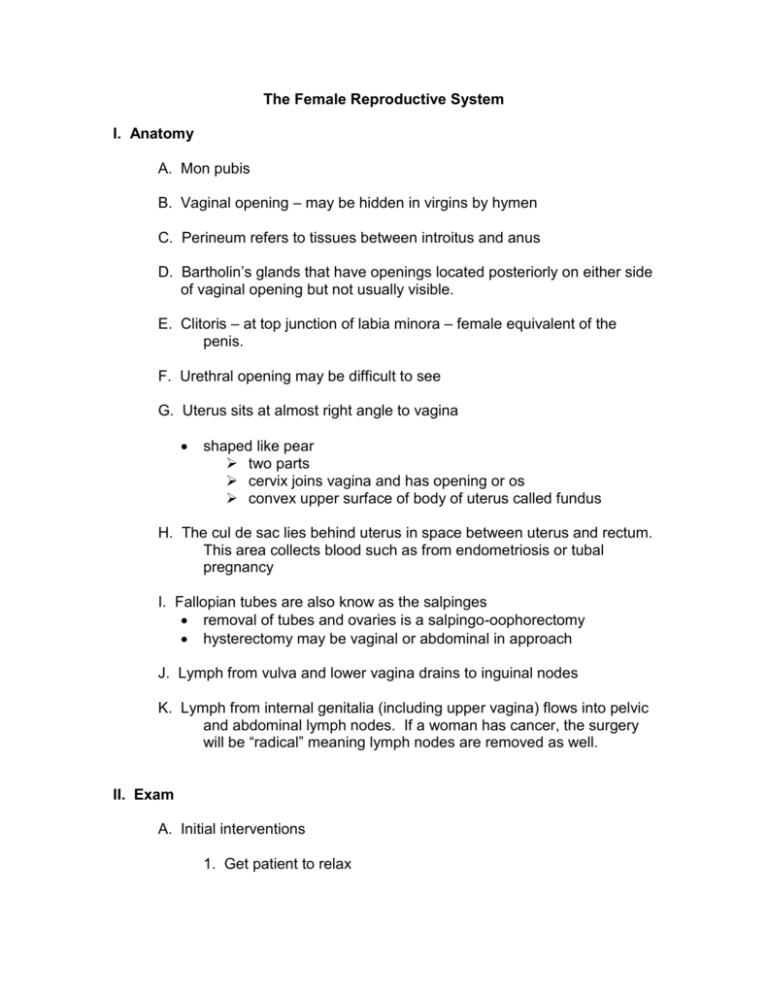
The Female Reproductive System I. Anatomy A. Mon pubis B. Vaginal opening – may be hidden in virgins by hymen C. Perineum refers to tissues between introitus and anus D. Bartholin’s glands that have openings located posteriorly on either side of vaginal opening but not usually visible. E. Clitoris – at top junction of labia minora – female equivalent of the penis. F. Urethral opening may be difficult to see G. Uterus sits at almost right angle to vagina shaped like pear two parts cervix joins vagina and has opening or os convex upper surface of body of uterus called fundus H. The cul de sac lies behind uterus in space between uterus and rectum. This area collects blood such as from endometriosis or tubal pregnancy I. Fallopian tubes are also know as the salpinges removal of tubes and ovaries is a salpingo-oophorectomy hysterectomy may be vaginal or abdominal in approach J. Lymph from vulva and lower vagina drains to inguinal nodes K. Lymph from internal genitalia (including upper vagina) flows into pelvic and abdominal lymph nodes. If a woman has cancer, the surgery will be “radical” meaning lymph nodes are removed as well. II. Exam A. Initial interventions 1. Get patient to relax 2. Ask patient to empty bladder 3. Elevate head and shoulders slightly and drape thighs and knees 4. Arms at sides or across chest 5. Warm hands and speculum with warm water B. Equipment 1. Light 2. Speculum 3. Water-soluble lubricant 4. Equipment for Pap or culture C. External Exam 1. Inspection 2. Palpate any lesions 3. Check Bartholin’s glands, if history or appearance of labial swelling If history of appearance of labial swelling, check Bartholin’s gland Insert index finger into vagina near posterior end of introitus with thumb outside posterior part of labia majora Palpate each side between thumb and finger for swelling or tenderness Note discharge from duct opening 4. Milk urethra with index finger (gently from inside out if suspicion of urethritis or inflammation of paraurethral glands) D. Internal Exam 1. Speculum insertion technique: a. Two fingers at introitus pressing downward on perineum b. Using other hand, insert speculum at a downward angle. Avoid pulling pubic hair or pinching labia. c. To avoid discomfort from pressure on urethra (very sensitive) Hold blades obliquely d. Slide speculum inward along posterior vaginal wall e. After speculum is in vagina completely, remove fingers from introitus f. Rotate blades to horizontal position (maintain pressure posteriorly) g. Insert speculum to full length 2. Inspect cervix (full view) a. Cervix divides fornix into anterior, posterior and lateral fornices b. Vaginal surface of cervix called ectocervix c. Ectocervix covered by epithelium 3. Obtain two specimens for cervical cytology (Papanicolaou smear) a. One from endocervical canal – use brush b. One from the ectocervix – use scraper 4. Perform bimanual exam a. Lubricate index and middle fingers of gloved hand b. Stand up and insert fingers into vagina c. Place other hand on abdomen d. Elevate cervix and uterus with pelvic hand and press abdomen hand down to grasp uterus between hands 5. Check ovaries a. Ovary – almond- shaped 3.5x2x1.5 cm and is often NOT palpable b. Normal fallopian tube not felt c. Adnexa – refers to ovaries, tubes, supporting tisues 6. Assess strength of pubic muscles: a. Withdraw two fingers slightly to touch sides of vaginal wall b. Ask patient to squeeze muscles around fingers as hard and long as possible Normal squeeze should compress fingers snugly and move them up and inward (lasting 3 seconds or more) Impaired strength due to age, vaginal delivery or neuro deficit With weakness ask about urinary stress incontinence and difficulty with bowel movement Cystocele – Only bladder involved Rectocele – Bulging of posterior wall of vaginal and rectal wall behind it 7. Perform rectovaginal exam to assess for fullness in cul-de-sac. Also used to test stool for occult blood. a. Insert index finger into vagina b. Insert middle finger in rectum c. Ask patient to strain down to relax anal spincter III. Sexually Transmitted Diseases Refer to photos in Seidel Infection of Genitalia and Discharge Cause and Treatment Genital herpes – ulcerated lesions without discharge. Can be Herpes simplex Type I or Type II Causes tingling, itching, pain, pustules, vesicles, ulcers and then excruciating pain. There is no known cure although Acyclovir may be helpful in controlling acute eruptions. Up to 65% of infected newborns die if they contract herpes during vaginal delivery. Therefore, csection is indicated for active infection during pregnancy. Predisposes to cervical cancer. Candidiasis – odorless, thick, cheesy discharge. Also called yeast infection, thrush or moniliasis. Caused by Candida albicans. This organism is often present in healthy persons without causing symptoms. Anything that alters or destroys normal vaginal flora – antibiotic therapy, diabetes which may compromise the immune system, high hormone levels of pregnancy – may lead to this infection. May infect skin or mouth also. May be transmitted to male partner. Commonly, treatment is with a fungicide. Trichomonas vaginalis – copious, frothy, malodorous, greenish-yellow discharge. Caused by an anaerobic protozoan (parasite that is turnip-shaped with flagellae). This parasite feeds on the vaginal mucosa. It may be transmitted sexually. The organism may reside in other structures so systemic treatment is recommended. Metronidazole is recommended. Infection of Genitalia and Discharge Cause and Treatment Condylomata accuminata (genital warts) - no discharge STD caused by human papilloma virus. May be invisible to human eye or there may be significant warts. Significant relationship between this condition and cervical, vulvar and penile cancer. May be treated (although rarely eradicated) with chemotherapy, laser surgery, electrocautery. May be considered a sexually transmitted neoplastic condition. Chlamydia trachomatis – causes frequency, dysuria and mucopurulent vaginal discharge or may be asymptomatic Caused by an obligate bacterial pathogen closely related to gramnegative bacteria. It requires tissue culture for isolation, but responds to tetracycline or doxycycline. Can cause PID and result in infertility. Gonorrhea – may be asymptomatic or cause a purulent discharge. Caused by Neisseria gonorrhoeae – a bacterial infection that may lead to PID. Can be treated with antibiotics. Can cause PID and result in infertility. Syphilis – symptoms differ according to stage. Caused by Treponema pallidum. First symptom may be a papule on vagina or cervix that becomes ulcerated (cancre). Usually accompanying lymphadenopathy. Can progress to cause major systemic involvement. Diagnosis is based on serologic tests (VDRL, for example). Treatment is with penicillin. The only sure way to prevent the majority of these horrible, potential life-destroying infections. Abstinence from sexual intercourse until a monogamous sexual relationship is established within the confines of lifelong commitment.
